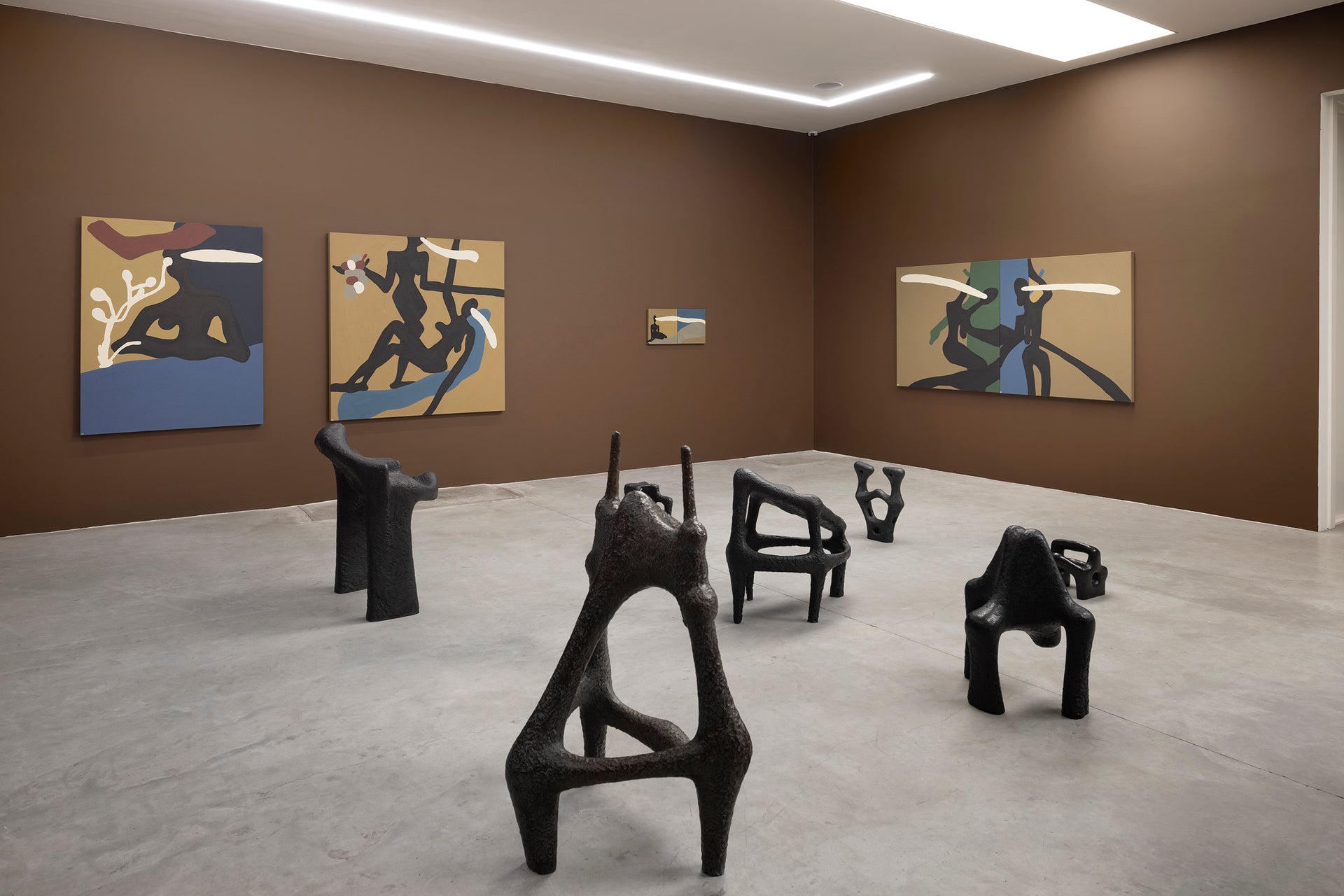Common Efforts – Intaka Yakha Ngoboya Benye
Common Efforts - Intaka Yakha Ngoboya Benye
An exhibition by Lulama Wolf in dialogue with Sonja Ferlov Mancoba
OPENING RECEPTION: WEDNESDAY AUGUST 23. 2023. TIME: 16.00 - 21.00
EXHIBITION PERIOD: AUGUST 24. - SEPTEMBER 23. 2023
“Intaka Yakha Ngoboya Benye” (A bird builds (its nest) with the feathers of another (bird))
- isiXhosa proverb
“Only through each other can we live and breathe, and no-one creates alone.”
- Sonja Ferlov Mancoba
“She strove to promote community and expression for all, and I strive to unite that intention by sharing mine and my ancestors’ DNA.”
- Lulama Wolf
Eighteen is pleased to present the first major exhibition by South African painter Lulama Wolf in the Nordic region. Common Effort - Intaka Yakha Ngoboya Benye exposes a new body of work created in dialogue across generations and continents, with works of the late Danish-French sculptor Sonja Ferlov Mancoba (1911-1984). A founding member of the CoBRA, Ferlov Mancoba was also the creative life partner of South Africa’s pioneering avantgarde painter Ernest Mancoba (1904-2002), whose work and legacy has inspired and nurtured generations of artists, Wolf notwithstanding. Borrowing its title from the Ferlov Mancoba sculpture Effort Commun, which Wolf mirrors with a proverb in her native language isiXhosa, the exhibition seeks to unite the two artists’ intentions of affirming community and togetherness by exploring the potential of generative difference.
Divided by the vastness of time and space, Lulama Wolf and Sonja Ferlov Mancoba nevertheless share multiple interests. Each balancing between abstraction and figuration, their works investigate different avenues of human expression and bodily experience. The sand-covered surfaces of Wolf’s canvases have a tactile and sculptural quality. Paired-back yet dynamic compositions with black figures, often female, commune physically and intellectually with each other. Long, flowing limbs intertwine with flora and features of the landscape. We sense the reverence for nature, but not in the hierarchical mode of Western metaphysics. Rather, the human and non-human in these works seem to co-create each other. The landscape carries the figures, yet they also seem to carry the land. While faces and personal identities remain undefined, Wolf concretizes the relationship between different elements: Acts of speech, thought and gaze manifest as undulating, loosely oval shapes in the compositions, flowing from the figures and connect different parts into a whole. We understand intuitively that the active, embodied agency she depicts, emerges in the space between individuals.
Wolf is concerned with that which she calls “proof of existence”. Indeed, history carries pain and erasure for previously colonized people, whose accumulated wisdom and art, often remembered and passed on orally through time, were systematically destroyed or omitted after centuries of subjugation. Incorporating crafting techniques as well as spiritual and philosophical ideas of Xhosa art and architecture, Wolf says:
“I express my yearning for answers and clarity in ways that make my blackness clear even when the work is abstract. My practice embodies subtlety in a form of texture and expression, a curious mix of ambiguity and curiosity. I experiment with different textures and molds that are formed from the earth."
Ironically, it was exactly the influx of non-Western art and artists which made possible the explosion of newness that the European avantgarde has come to represent by the end of the 19th century - a fact not lost on Sonja Ferlov Mancoba. Marginalized in her own time, Ferlov Mancoba has in recent years been subject to comprehensive research, emphasizing her affiliation with groups such as CoBRA and Linien, and reexamining her contribution to the development of modernism as it were. For Ferlov Mancoba, pre-colonial art, written out of the established cannon, represented a richer, more nuanced yet also more humane reflection of our existence in the world. But unlike many of her male, European colleagues, who projected their own fetishistic ideals of so-called “primitivism” onto non-Western art, Ferlov Mancoba sought to engage with cultural difference with universal compassion and understanding. Rejecting the term “primitivism”, she writes to her contemporary Asger Jorn, quoting a ubuntu proverb: “Umuntu ngu’ muntu nga’ banye abantu”, loosely translating to “people depend on people to be people”. In other words, humanity is made possible only by the grace of other humans. The importance of this ethos cannot be overstated in the interpretation of her work.
In the contemporary context in which necessary discussions of artistic genealogy, representation and ownership are still ongoing, Ferlov Mancoba’s oeuvre, and particularly how to frame her sources of inspiration and humanist legacy, is yet subject of contention. In between the two women artists, however, one thing is clear: The singular, individualistic subject, and the confining dialectics of sameness/alienation imposed by Western humanism take a backseat. We are prompted instead to wonder about alternative definitions of humanity, modes of community and ways of relating to each other - and the natural world. Here, Wolf generously engages with Ferlov Mancoba, returning her ethos of universal compassion and solidarity, combining their artistic visions in a common effort.
Lulama Wolf, b. 1993, lives and works in Johannesburg, South Africa. At the intersection of Neo-Expressionism and Modern African Art, Wolf interrogates the precolonial African experience through the contemporary mind by using smearing, scraping, and deep pigment techniques that were used in vernacular architecture, and the patterns created largely by women to decorate traditional African homes. She has exhibited widely in South Africa and Europe. Recent exhibitions include: Ayakha: Indlela Yokuxola (Rebuilding: The Path to Forgiveness), THK Gallery, Johannesburg, South Africa, The Right to Ease, The Breeder, Athens, Greece, and Africa Now: Contemporary Painters, THK Cologne, Germany. In 2022, she was introduced to the Danish audience for the first time by THK Gallery, at Enter Art Fair.
Our sincerest thanks go to: Estate Ferlov Mancoba, Galerie Mikael Andersen, THK Gallery,
and our sponsor: Flügger
Text by Astrid Wang, Director, V1 Gallery & Eighteen










